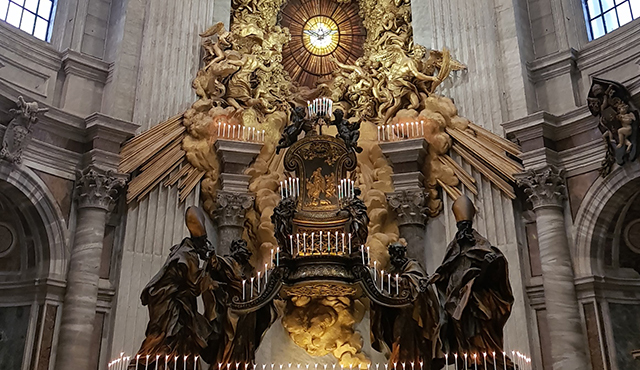On Feb. 22, we celebrated the feast of the Chair of St. Peter. When I was living in Rome, this was one of my favorite occasions to visit the Vatican. I always made it a point to visit St. Peter’s Basilica every year on this beautiful day when the chair sculptured by Bernini (said to contain a chair that belonged to St. Peter himself) would be lit up with candles –– only on this day. I always used this occasion to pray for the successor of St. Peter, and in my time in Rome it was now St. John Paul II.
In some ways, it’s an unusual feast. It celebrates a thing, rather than a person. But the Chair of St. Peter, in fact, points to a person. It points to whomever is filling the office of Peter at a particular point in time. It also reminds us of all those who have held the office, starting with St. Peter himself.
Most of us know the saying, “The clothes make the man.” Well, in this case it is the chair, or rather the office, that makes the man, that makes him Pope. Only 266 men have held this office.
Now, anyone who knows some Church history knows that we Christians, from the very beginning – St. Luke wrote about this in the Acts of the Apostles – have disagreed on many things, sometimes to the point of fracture.
As early as the fourth century, Christians began celebrating the feast of the Chair of St. Peter to show the unity of the Church founded on the Apostle Peter (Mt 16:18), indicating that they were all too aware of the need to protect against dangerous divisions that would destroy that original unity.
Again, history makes evident our failures. Nevertheless, it also witnesses our triumphs. Frequently, people have noted that a mere human institution could never have survived 2,000 years. Again, look at history. If the Catholic Church had relied on the mere efforts of us creatures, she probably would not have lasted much beyond the time that St. Luke describes in his Acts. Despite our failures, petty and grievous alike, the Church continues to exist because She is divinely instituted.
Last week’s feast reminded me again of our responsibility to pray for the person who occupies this unique seat. In some ways, no matter who he is, he’s given a job that’s more than anything that he can do. At least, he cannot do it alone. He must be guided by the Holy Spirit, supported in grace and prayer.
The early Christians understood this reality. By celebrating the Chair of St. Peter in a liturgical manner, they were not just commemorating a relic from the past. They were acknowledging the presence of a holy and living trust that has been given to Christians: the papacy. They recognized that this was no mere human institution, but a divine one that required their cooperation – their prayers, sacrifices, and support.
Even though history and our present time both provide evidence of the failures of Christian unity, there are also indications that Christian unity is increasing. Christians of many denominations come together to work on various humanitarian issues, from taking care of the poor to fighting for legislation that respects the dignity of the human person and the family.
Much of this collaboration was inspired by the Popes of the past century. St. John Paul II significantly broadened this work to include people of other faith traditions, most notably with his first interfaith gathering in Assisi in 1986. These gatherings, presided over by the occupant of the Chair of St. Peter, continue more than 30 years later. Pope Benedict later called the event “an accurate prophecy.”
Yes, religious differences continue to divide humanity, nevertheless there is also evidence that we are eroding the differences to create unity.
The insight of the early Christians to commemorate this need for unity in liturgy focused on this object – an actual chair that tradition maintains St. Peter sat in while presiding at Mass – indicates how much we need to pray for whomever holds that office. Our own unity relies upon it, as does the unity of those outside the Church.
In the 17th century, the artist Bernini, as I mentioned above, created a bronze encasement for the chair so that it sits up from the ground behind the main altar in St. Peter’s Basilica. Above the chair, he depicted the Holy Spirit as a dove spanning its wings over the chair, a sign of both divine institution and divine support.
Bernini’s art reflected the theological truths about this divinely instituted office. After all, it was Jesus himself who said to Peter, “You are Peter and upon this rock I shall build my Church.” (Mt 16:18).
As the Father, Son, and Holy Spirit guide and protect God’s Church, we, too, are given the privilege of cooperating with them not only as we celebrate the feast, but as we pray for the man who holds that office in this moment in time: Our Holy Father Pope Francis.
Each time I have met Pope Francis, he has asked me to pray for him. I have sent the prayers and best wishes of our Diocese on a number of occasions, and following on the feast day of the Chair of St. Peter, we are given a very appropriate time and season to do just that.

